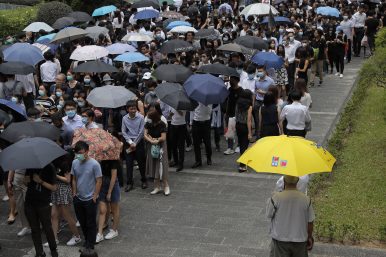By Jessie Lau
With blood streaming from one eye, a young female medic lies slumped on the ground after being hit by a beanbag round during clashes with riot police in a Hong Kong protest. Clouds of tear gas smother the interior of a subway station where protesters are fleeing from police, stumbling over one another on escalators. In a separate incident, thugs armed with metal rods and bamboo poles launch a brazen assault on train commuters. They attack indiscriminately, even as victims fall to their knees in surrender, begging their assailants to spare the women and children cowering behind them.
Such scenes have scorched the heart of Hong Kong since the start of this “summer of unrest,” when a now-suspended bill that would have allowed extradition to mainland China plunged the city into a state of crisis that has escalated to precipitous heights. What began as a largely peaceful anti-extradition protest that drew a historic 2 million to the streets has since transformed into an increasingly violent, anti-government and anti-police movement fighting for broader political reform, as well as an end to Beijing’s authoritarian interventions in the semi-autonomous territory.
Since June, protesters have been deadlocked with Hong Kong’s pro-Beijing leader Carrie Lam – who has done little to respond to demonstrators and distanced herself at critical moments – as well as the local police. The resulting clashes have rendered the city unrecognizable. Police and protesters engage in regular battles that involve tear gas, pepper spray, bean bag rounds, and water cannons. A city-wide strike paralyzed public transport, parliament was ransacked, and a Chinese flag was thrown into the sea. At least 700 demonstrators, consisting of mainly young people, have been arrested and could be charged with rioting, a charge that carries a jail term of up to 10 years. Several protesters have committed suicide. Airport demonstrations led to the cancellation of hundreds of flights, before taking a dark turn when protesters attacked mainland Chinese men suspected of being undercover cops and a police officer drew his pistol on a crowd after being beaten with his own baton in a brawl. On August 12, China’s spokesman for the Hong Kong and Macao Affairs Office said the protests show “signs of terrorism.”
Unlike the mostly-peaceful Occupy Central and Umbrella Movement that stunned the world five years back, the current movement is seen by many protesters as the city’s “last stand” – a critical shift reflected in its rallying cry “Liberate Hong Kong; revolution of our time,” now ringing across the territory.
“It’s like the myth of Sisyphus. We keep pushing a rock and it keeps rolling back, and there are no results,” said George Tsang, a 27-year-old protester. “It doesn’t matter if people see you as peaceful protesters – the government still doesn’t care. The atmosphere is desperate.”
The protests mark the most significant social movement in Hong Kong history, as well as the greatest challenge to mainland Chinese rule, since the former colony was handed over to Beijing by the British in 1997. But beyond that, the movement also represents the first political awakening since the Tiananmen Square massacre in 1989 that has traversed social divisions and established city-wide solidarity – one that has paved the way for a collective claiming of a Hong Kong identity and political community on a scale beyond anything the territory has witnessed before.

